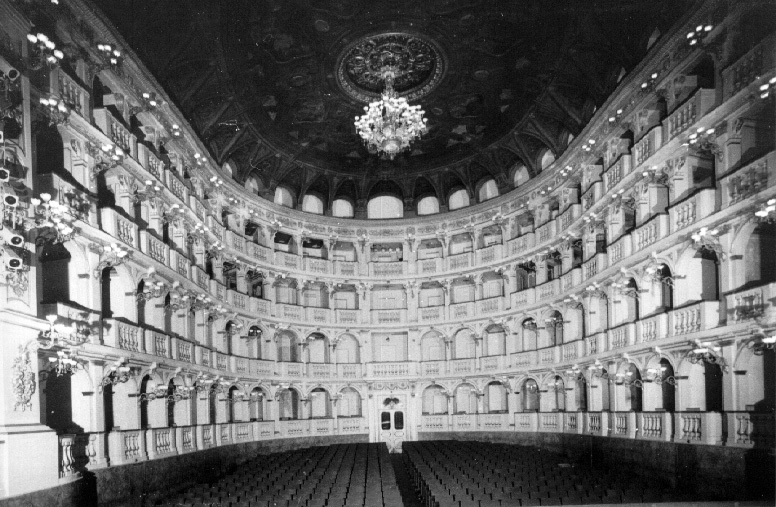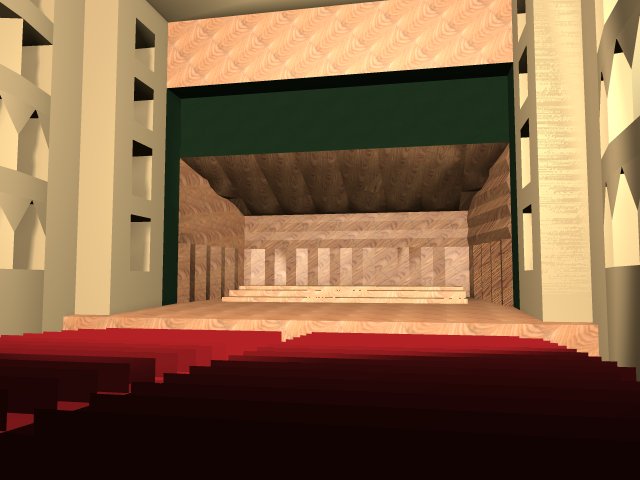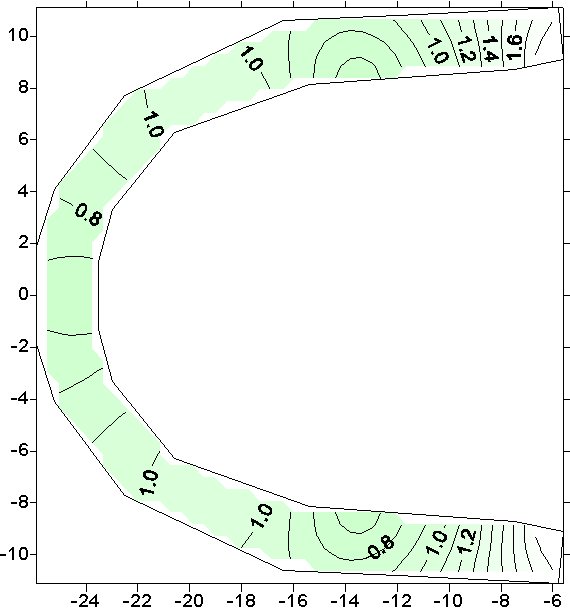Acoustical Society of America
ICA/ASA '98 Lay Language Papers
Boxes and Sound Quality
in an Italian Opera House
in an Italian Opera House
Alessandro Cocchi -
alessandro.cocchi@mail.ing.unibo.it
Massimo Garai and Carla Tavernelli
DIENCA, University of Bologna
viale Risorgimento 2
40136 Bologna, ITALY
Popular version of paper 2aAAb1
Presented Tuesday morning,
June 23, 1998
ICA/ASA '98, Seattle, WA
THE THEATRE
The object of the present study is the "Teatro Comunale" (City theatre)
in Bologna, an Italian opera house of the 18th century, designed by Antonio
Galli Bibiena.
The theatre has a "bell" shape in plan, four order of boxes plus a gallery
on the walls and a vaulted ceiling.
There are 540 upholstered seats on the wooden floor of the stall and 466
in the boxes and in the gallery.

The Teatro Comunale in Bologna, Italy.
THE BOXES: SOUND ABSORPTION AND EFFECT OF CAVITIES
There are two different mechanisms by which the boxes influence the sound
field in the hall: the sound absorption of the box internal walls and
the whole effect of the cavities on the box-covered walls.
As it is impossible to alter an ancient theatre for studying these effects
in an experimental way, computer simulation is the only way to investigate
them.
A computer model of the theatre was built for use with the simulation
software Ramsete.
The model was validated using a procedure, elsewhere detailed (e.g. in a
paper presented at the MCHA 95 international congress),
to adjust the model geometry, the characteristics of the sound sources
and the sound absorption of the surfaces until the simulated results
match the measured ones.
Each orchestra section was simulated by a model source with the appropriate
sound power and directivity.
During the several restorations occurred in the theatre, the velvet
lining and curtains of the boxes were almost completely removed and now
it is difficult even to guess the acoustic characteristics of the original
materials.
At present, the theatre is claimed to be more "live" than similar Italian
opera houses.
Thus, the first aim of the present study was to assess how and how much
the introduction of some modern fabric lining or curtains in the boxes
could change the theatre acoustics.
In other words, the work shows how the sound in the historical theatre could be if
the absorption of the box internal walls were changed, e.g. adding some
velvet lining or curtains, which are supposed to exist in ancient times.
In the computer model, velvet curtains were added into the boxes and the
simulation results were compared to those obtained for the actual
all-plaster boxes.
For several acoustic quantities, the change from the actual situation was
computed and averaged over the stall.
For example, the reverberation (sound tail) of the room is reduced, due
to the added absorption.
The predicted variations are non-uniform over the audible frequency range,
because the sound absorption coefficient of the velvet curtains takes into
account an air gap between the curtains and the wall.
Computer simulation can also help in understanding the role of the
cavities which constitute the boxes: the effect of these cavities was
"cancelled" inserting in the computer model a smooth wall closing the
opening of each box. simulations show that without the box cavities the reverberation
would be reduced at low frequencies and enhanced at high frequencies.
The hypothesis can be made that at low frequencies the boxes act as
resonators to sustain the reverberant sound, while at high frequencies
they are "sound traps" which recall some energy from the hall.
The transition is smooth and located in between the low- and mid-frequency regions.
This hypothesis would confirm that the "warmth" of Italian opera houses
is also due to the box-covered walls.
The same simulation shows that the effect on loudness of sound would be very small, as
the temporal redistribution of sound energy doesn't affect its overall
value.
DESIGN OF A NEW ORCHESTRA SHELL
As measurements revealed that the actual orchestra shell is not
completely suited to the theatre, a completely new orchestra shell
has been designed by means of computer simulation.
The new shell has a variable configuration to be made suitable for
different orchestra sizes, with and without chorus; it has diffusing
surfaces and a shape exactly fitted to uniformly redirect the sound on
the stall and to prevent the problem of late arrival
of sound into the central boxes.

Rendering of the newly designed orchestra shell.


Improvement of the listening "clarity" (technically speaking: in the C80 values in decibels) in the 2nd order boxes (left) and in
the stall (right) with the newly designed orchestra shell (in the configuration
without chorus) in place of the actual orchestra shell.